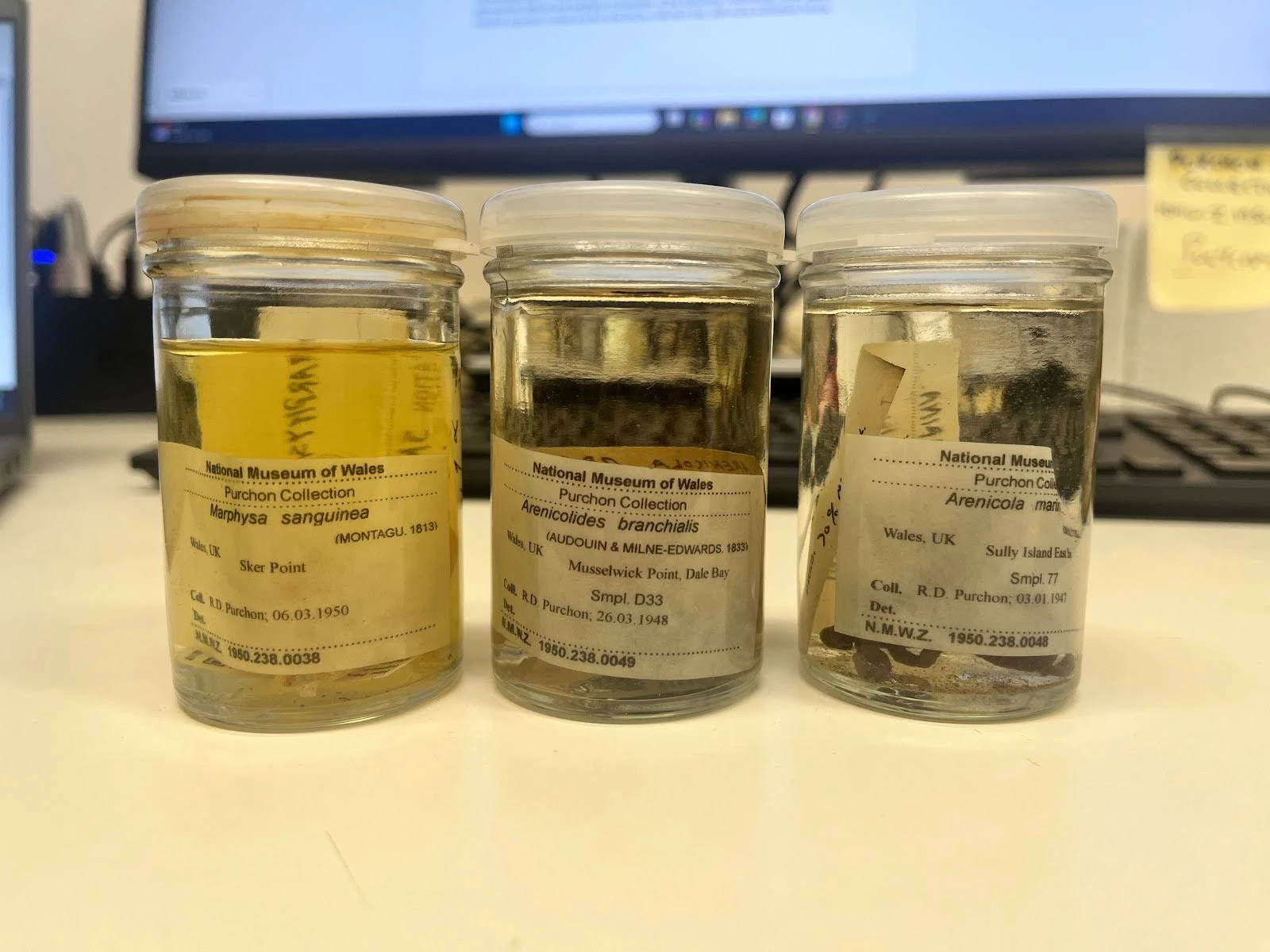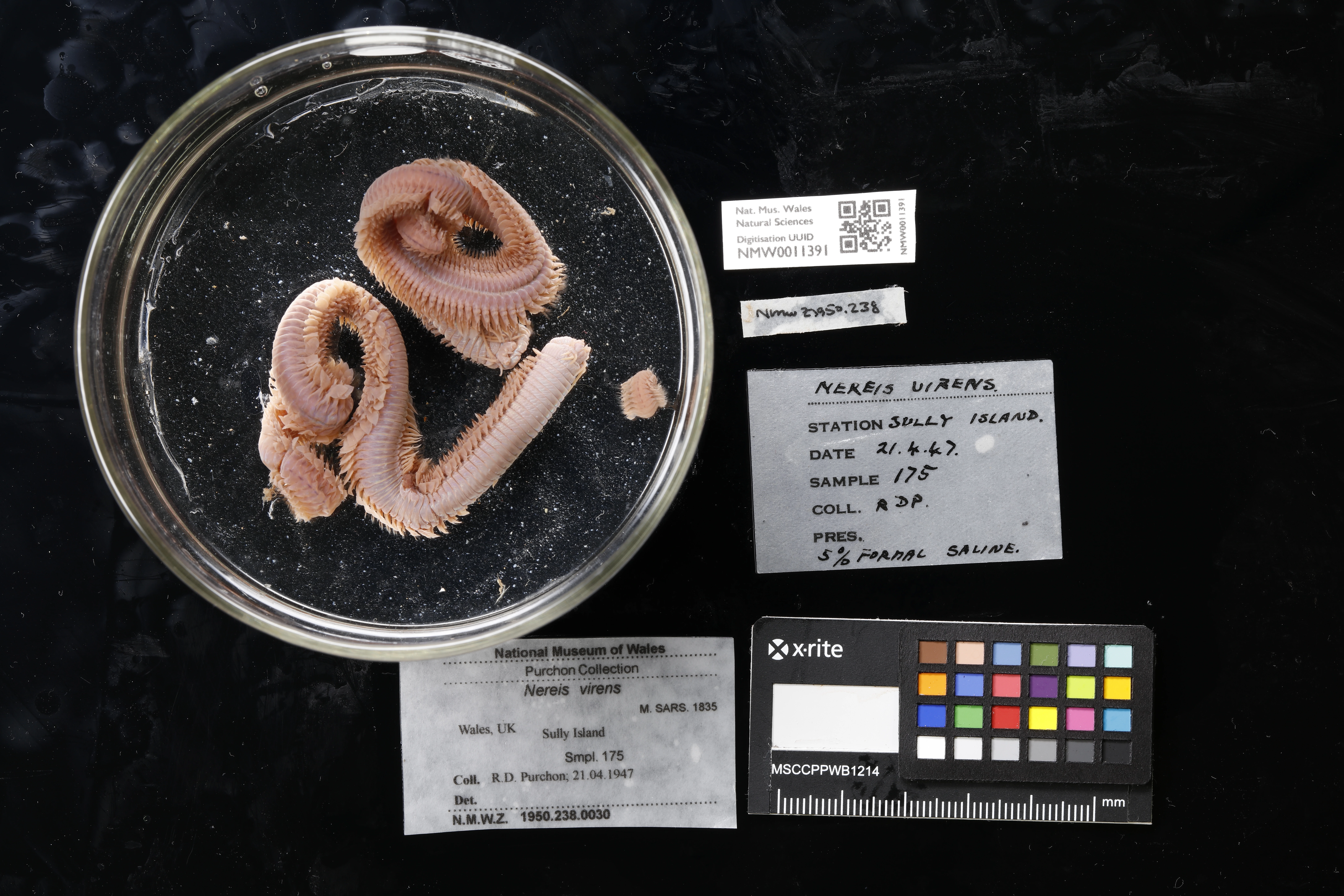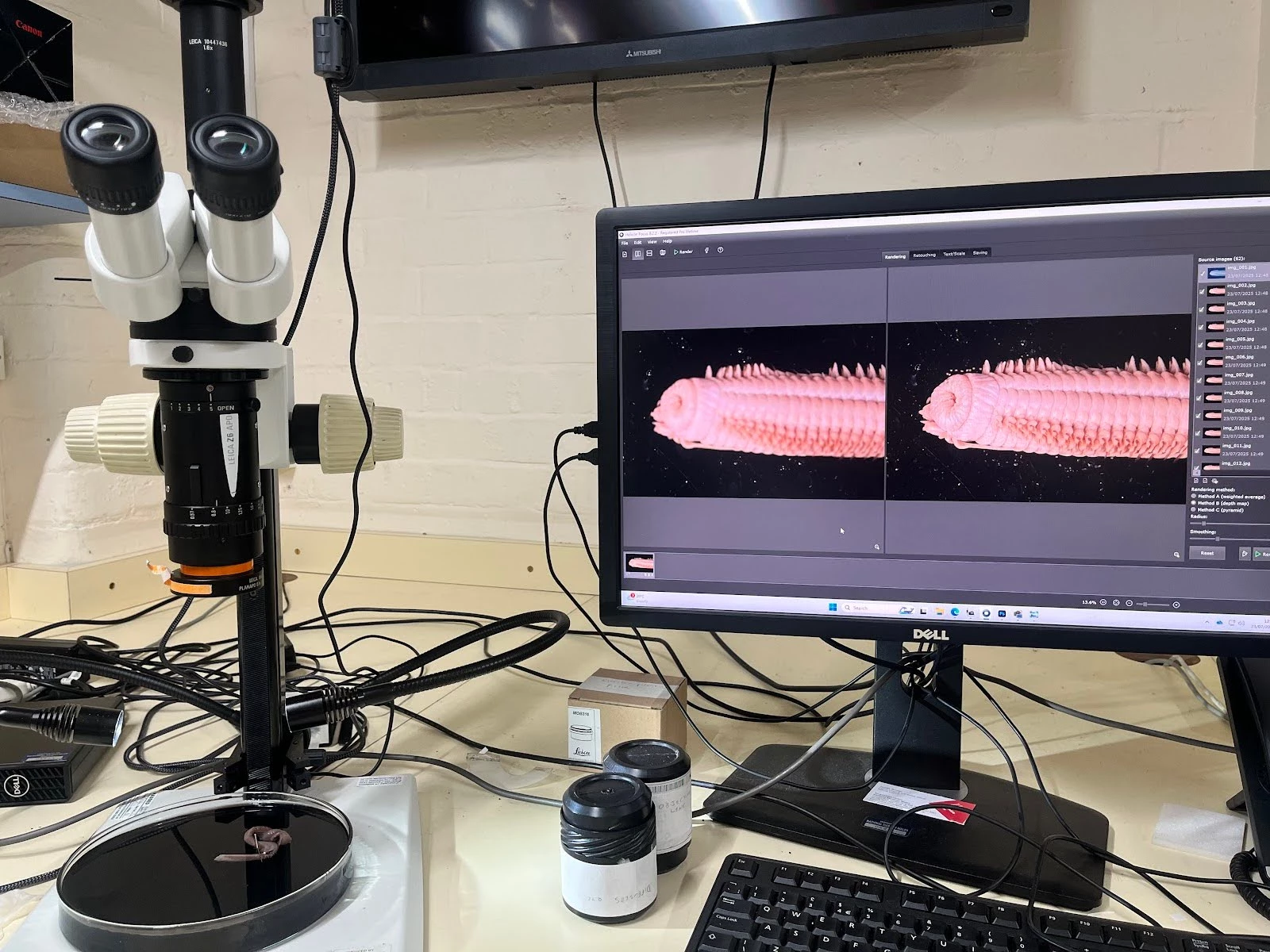Parti Lleoliad Llyngyr Gwrychog - Straeon gan fyfyrwyr sydd ar leoliadau ac yn gweithio ar lyngyr gwrychog morol
, 26 Awst 2025
Mayu Seguchi
Helo, Mayu Seguchi ydw i ac rydw i newydd ennill gradd BSc (Anrh) mewn Bioleg Bywyd Gwyllt Rhyngwladol o Brifysgol De Cymru. Y cwestiwn mwyaf cyffredin yr ydw i wedi ei gael ers symud i ffwrdd o fy nhref fach ym Michigan yw "Pam Cymru"? Rwy’n ateb yn syth, bob tro, drwy ganmol y cwrs prifysgol oherwydd bod cymaint o deithio yn rhan o’r cwricwlwm. Mae gen i straeon am fy mhrofiadau - am y gyr o eliffantod Affricanaidd wnaeth ein bygwth ni yn Ne Affrica, neu am nofio mewn afon hyfryd yng Nghoedwig Law Chiquibul yn Belize, wrth i adar seithliw hedfan uwch ein pennau. A byddaf yn siŵr o sôn wrth unrhyw un sy’n fodlon gwrando sut i mi blymio naw gwaith i’r ail farriff mwyaf yn y byd, a sut y gwnaeth hynny agor llwybr newydd ac annisgwyl i mi i fyd bioleg forol. Mi es i mor bell â dewis traethawd hir ar yr iguana er mwyn i mi allu byw ar ynys fach oddi ar arfordir Honduras am ddau fis, gan blymio a snorclo bob munud sbâr.
Felly, pan ddaeth cyfle yn Amgueddfa Genedlaethol Caerdydd i weithio gyda llyngyr gwrychog morol, aka polychaetes, roedd yn rhaid imi gyflwyno cais. Yn fy niwrnod cyntaf, osgoi mynd ar goll ar hyd llwybrau dryslyd coridorau’r amgueddfa oedd y brif dasg ac yna dechrau dysgu am y dulliau digideiddio y mae’r amgueddfa yn eu defnyddio ar gyfer sbesimenau. Dim ond ar ôl imi gael trefn ar bethau a dechrau gweithio gyda’r casgliad y sylweddolais pa mor anhygoel ydoedd mewn gwirionedd. Cafwyd y samplau gan R. D. Purchon o bum lleoliad ar hyd Môr Hafren: Llan-bedr Gwynllŵg, Ynys Sili, Harbwr y Barri, Breaksea Point, a Thwyni Dale. Mae hyn yn golygu bod pob sbesimen rwy'n ei drin wedi byw yn nyfroedd Cymru o amgylch Caerdydd! A finnau wedi teithio dramor ar gyfer fy ngwaith maes i gyd, roedd yn hawdd cael fy swyno gan farriffiau lliwgar a mamaliaid morol mawr. Ond mae'r casgliad hwn wedi agor fy llygaid i'r bylchau yn fy ngwybodaeth am rywogaethau rydw i’n rhannu fy nghartref â nhw ac sy’n rhoi cyfle i mi ddysgu mwy. Felly, erbyn hyn, pan fydd pobl yn gofyn i mi pam y symudais i Gymru, rwy’n gallu ateb "Pam lai?” Gyda’r holl fywyd gwyllt hardd, o balod i lyngyr gwrychog, mae cymaint i'w ddarganfod.
Mewn amgueddfeydd sydd â chasgliadau mawr, fel Amgueddfa Cymru, mae bron yn amhosibl cofrestru pob sbesimen sy'n dod i law. Fodd bynnag, mae hyn yn cyfyngu ar faint o wybodaeth y gallwn ei ganfod am rywogaeth, ac mae hynny'n cynnwys gwybodaeth sy’n werthfawr i ffawna Cymru a'r DU. Felly, cafodd fy nghydweithwraig, Caitlin Evans (gweler isod), a minnau y dasg o 1) curadu'r sbesimenau yng nghronfa ddata yr amgueddfa a 2) tynnu llun o bob sbesimen a’i atodi. Byddaf yn trafod y fethodoleg a ddefnyddiwyd ar gyfer curadu'r casgliad gan Purchon (1950), cyn i Caitlin esbonio sut yr aethon ni ati i ddelweddu ein gwaith gyda'r llyngyr gwyrchog.
I guradu'r casgliad, defnyddiais gronfa ddata FileMaker Pro gyda thempled a ddatblygwyd gan yr amgueddfa (Ffigur 1). Ar gyfer pob sbesimen, cofnodais enw'r casgliad, rhif derbyn (rhif unigryw sy'n ein galluogi i leoli pob sbesimen), a dyddiad casglu'r sbesimen, yn ogystal â theulu, genws a rhywogaeth y sbesimen. Roedd pob sbesimen hefyd yn nodi safle casglu sydd, o'i baru â thraethawd PhD R. Denison Purchon ar The Littoral and Sublittoral Fauna of the Northern Shores, near Cardiff a Dale Fort Marine Fauna a olygwyd gan J.H. Crothers, yn rhoi'r wybodaeth angenrheidiol i mi bennu cyfesurynnau hydred a lledred bras yr ardal lle tarddodd y sbesimen. Hefyd, roedd y papurau hyn yn cynnwys llawer mwy o gyd-destun ar gyfer safleoedd casglu'r sbesimenau, gyda rhai unigolion yn disgrifio'r gwaddodion lle cawsant eu darganfod. Ar ôl cofnodi'r gwaddod a chwblhau'r dogfennau hyn, byddai gwybodaeth adnabod allweddol yn cael ei hargraffu ar labeli llai i'w cadw yn y jar gyda'r sbesimen (Ffigur 2). Gyda'r casgliad wedi'i guradu'n llawn ar gronfa ddata yr amgueddfa, roedd hi'n bryd dechrau'r broses ddelweddu.
Caitlin Evans
Dychmygwch allu dysgu am anifeiliaid sy'n gwbl angof i bobl ac ymchwilio iddynt. Infertebratau morol yw’r llyngyr gwrychog, a dydy rhai pobl ddim hyd yn oed yn gwybod amdanyn nhw oherwydd eu natur o gloddio yn y tywod. Maen nhw'n byw ar hyd traethlinau a llanw ein hoff draethau ac mae’n hawdd i rywun beidio â sylwi arnyn nhw o gwbl. Caitlin ydw i, myfyrwraig Bioleg sydd ar flwyddyn olaf fy ngradd israddedig ym Mhrifysgol De Cymru. Ar hap y daeth y cyfle i mi weithio ar leoliad yn Amgueddfa Cymru - doedd gan i ddim bwriad go iawn i fynd ar leoliad. Ond pan soniodd un o'm darlithwyr am y cyfle hwn, roeddwn i'n gwybod bod rhaid i mi fachu ar y cyfle. Pan ddechreuais yn y brifysgol, doeddwn i ddim yn siŵr pa faes i’w ddilyn. Ond cyn gynted ag y dechreuais i astudio ecoleg a sŵoleg, taniwyd diddordeb angerddol yn y pwnc. Teithiais i goedwig law ac arfordir Belize am fis, gan ennill profiad ymarferol a chael cipolwg heb ei ail ar sut brofiad fyddai gweithio yn y maes. O rwydi dal adar ac ystlumod i sgwba ddeifio, fe wnaeth y profiad hwn atgyfnerthu fy niddordeb. Ar hyn o bryd, rwy'n casglu data ar gyfer fy mhrosiect traethawd hir ar boblogaethau ystlumod, gan gasglu data ar gyfer yr Ymddiriedolaeth Cadwraeth Ystlumod ynghyd â chwblhau'r lleoliad hwn, sy'n golygu bod fy wythnosau i'n llawn dop o weithgareddau sŵoleg.
Yn ystod fy amser yn yr amgueddfa, cefais y dasg o guradu a chwblhau gwaith delweddu ar Gasgliad Mendelssohn gan fy ngoruchwylydd Dr Teresa Darbyshire (Uwch Guradur: Infertebratau Morol). Mae hwn yn gasgliad enfawr o tua 115 o sbesimenau sydd wedi'u cadw mewn hylif. Maen nhw'n amrywio o samplau bach y gallwch prin eu gweld i lyngyr mawr sydd prin yn ffitio yn eu jariau. Mae'r sbesimenau sydd yn y casgliad hwn i gyd wedi'u casglu ar ynys Guernsey gan J.M. Mendelssohn ac wedi eu cadw mewn ethanol. Mae gweithio gyda'r casgliad hwn wedi fy helpu i werthfawrogi bioamrywiaeth rhan o’r byd sy’n anghyfarwydd i mi. Mae'n rhoi cipolwg heb ei ail ar fyd natur yr ardal honno.
Fel i Mayu grybwyll, roedd y dasg o guradu'r casgliad hwn yn cynnwys chwilio'n drylwyr trwy draethawd ymchwil PhD Mendelssohn o 1976 er mwyn darganfod union leoliadau casglu'r sbesimenau hyn. Trwy ddefnyddio'r traethawd ymchwil a chymorth Google Maps dibynadwy, roedd modd i mi bennu cyfesurynnau hydred a lledred ar gyfer pob sbesimen a'u cofnodi yn y gronfa ddata. Cafodd pob manylyn ei nodi ar y gronfa ddata gan gynnwys yr holl wybodaeth dacsonomaidd a hyd yn oed manylion gwaddodion. Ar ôl cwblhau hyn ar gyfer pob sampl, aethom ati i baratoi labeli ffres ar gyfer y samplau hylif corfforol. Roedd hyn yn cynnwys agor y samplau a rhoi label newydd yn y jar. Dull hawdd a chyflym o adnabod y sbesimen.
Y cam nesaf fyddai llywio'n ffordd trwy'r ddrysfa i lawr i'r ystafell ddelweddu. Roedd y broses o ddelweddu'r sbesimenau hyn yn cynnwys y profiad corfforol o sut i ymdrin â sbesimenau hylif wedi'u cadw, yn y ffordd gywir. Roedd tynnu'r llyngyr gwrychog wedi'u cadw allan o'r jar a dadansoddi manylion anhygoel a nodweddion esblygiadol y llyngyr hyn yn wirioneddol anhygoel. Roedd y gwaith delweddu yn rhoi cyfle i ni ennill sgiliau na fydden ni byth wedi'u datblygu oni bai am yr amgueddfa, gan gynnwys sut i drafod hen sbesimenau yn iawn - a chawsom hefyd ein trwytho mewn ffotograffiaeth. Yn ystod ein hamser yn yr amgueddfa, buom yn ddigon ffodus i dreialu project DISSCO (System Ddosbarthedig ar gyfer Casgliadau Gwyddonol) sy'n cynnwys digideiddio casgliadau'r amgueddfa. Mae’r project helaeth hwn yn cynnwys POB casgliad, a'r gobaith yw y bydd y casgliadau morol yn rhan ohono rywbryd yn y dyfodol (Ffigur 3).
Cam cyntaf y broses ddelweddu yw cwblhau delwedd archwilio, sef tynnu llun o bopeth sy'n bresennol yn y jar (Ffigur 4). Gan ddefnyddio gefeiliau, byddem yn tynnu'r sbesimen allan a'i roi mewn dysgl petri llawn ethanol. Byddem wedyn yn cymryd yr holl labeli, hen a newydd, ac yn eu gosod yn daclus mewn ffrâm. Yna, byddem yn ychwanegu cod QR ar gyfer proses DISSCO. Ar ôl tynnu lluniau o du blaen a thu ôl y labeli a'r sbesimen, byddem wedyn yn symud ymlaen i'r delweddau o’r sbesimen. Mae Ffigur 5 yn dangos manylion y sbesimen, er enghraifft mae gan Arenicola marina nifer benodol o 'gylchoedd' ar ei ben a ddefnyddir i'w adnabod. Mae'r broses hon o ddelweddu sbesimenau yn golygu tynnu sawl llun ar lefelau ffocws gwahanol, sydd wedyn yn cael eu cyfuno i greu ffotograff hynod glir a manwl. Yna, rydyn ni'n defnyddio meddalwedd Helicon Focus i rendro'r ddelwedd derfynol hon cyn ei throsglwyddo i Photoshop i ychwanegu bar graddfa. Cwblhawyd y broses hon ar gyfer fy nghasgliadau i a Mayu (Ffigur 5). Byddem yn cyfnewid tasgau’n rheolaidd, gan roi cyfle i ni feithrin ein sgiliau delweddu ymhellach (Ffigur 6). Ein tasg olaf yn ystod ein hamser yn yr amgueddfa oedd defnyddio Photoshop i olygu ein delweddau i'w gwneud yn lân ac yn daclus.
Mae'r profiad ar leoliad wedi caniatáu i ni ennill sgiliau gwerthfawr a fyddai’n amhosibl eu cael yn unrhyw le arall. Bu'n brofiad anhygoel sydd wedi agor y drws i fyd y gwyddorau naturiol ac mae’n gam anhygoel yn ein gyrfaoedd i’r dyfodol.
Roedd ein cyfnod yn yr amgueddfa yn llawn hwyl a rhyfeddodau, diolch i bawb yn yr adran gwyddorau naturiol. Yn ogystal â'r adran forol, cawsom bersbectif mewnol o sawl adran arall gan gynnwys fertebratau a botaneg - rydyn ni'n hynod ddiolchgar iddyn nhw, ac wedi meithrin cyfeillgarwch newydd trwy gydweithio. Diolch i'r staff ac i’n goruchwylydd, Teresa Darbyshire, am greu amgylchedd gwaith mor gynnes a chroesawgar ac am sicrhau amser anhygoel i ni yn yr amgueddfa. Rydyn ni wedi ehangu ein gwybodaeth yn aruthrol, ac allen ni ddim fod wedi gofyn am brofiad gwell.








